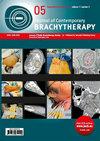局部晚期或复发性直肠癌术中电子束放射治疗剂量调整后的术后并发症
IF 1.1
4区 医学
Q4 ONCOLOGY
引用次数: 0
摘要
目的:术中放疗(IORT)在治疗局部晚期直肠癌(LARC)或局部复发直肠癌(LRRC)中的优势在于,它能够对有限的危险容积提供高剂量放射,从而消除微小病灶并降低毒性。一项名为术中近距离放射治疗(IOBT)的高剂量率近距离放射治疗(HDR)与术中电子放射治疗(IOERT)的比较研究显示,IOBT术后的LRFS较好,这可能是由于IOBT技术本身具有较高的表面剂量。埃因霍温 Catharina 医院对 IOERT 技术进行了调整,以提高表面剂量,从而改善局部控制。由于辐射剂量增加而导致的术后并发症仍然令人担忧。这项回顾性研究旨在比较 IOERT 剂量调整前后的并发症发生率。材料与方法:研究对象为 2019 年 9 月至 2023 年 7 月期间接受 IOERT 手术治疗 LARC 或 LRRC 的所有患者。2021年8月31日之前入选的患者被纳入对照组(108人),2021年9月1日之后入选的患者被纳入干预组(92人)。结果:在 LARC 患者中,术后并发症有所减少(P = 0.009)。19%的 LARC 患者术后出现了严重的手术并发症,即 Clavien-Dindo 3b-5 级,与治疗组无关。90 天的主要并发症无差异(P = 0.142)。在 LRRC 患者中,诱导化疗的使用率从 78% 降至 29%(p = 0.001),这使得比较更为复杂。结论:IOERT表面剂量的增加似乎不会导致术后并发症的增加。结论:增加 IOERT 的表面剂量似乎不会导致术后并发症的增加,还需要进一步的研究来评估 IOERT 剂量调整对提高局部肿瘤控制率的效果。在随访中对CTCAE评分进行常规评估将有助于发现可能的长期放射诱导毒性。本文章由计算机程序翻译,如有差异,请以英文原文为准。
Post-operative complications following dose adaptation of intra-operative electron beam radiation therapy in locally advanced or recurrent rectal cancer
Purpose:
The benefit of intra-operative radiotherapy (IORT) in the treatment of locally advanced rectal cancer (LARC) or locally recurrent rectal cancer (LRRC) lie in its ability to provide high-dose of radiation to limited at-risk volume, thereby eliminating microscopic disease and decreasing toxicity. A comparative study between high-dose-rate (HDR) brachytherapy, named intra-operative brachytherapy (IOBT), and intra-operative electron radiotherapy (IOERT) was performed showing favorable LRFS after IOBT, possibly due to a higher surface dose that is inherent in IOBT technique. The IOERT technique in Catharina Hospital Eindhoven was adapted to increase the surface dose, aiming to improve local control. Post-operative complications due to an increased radiation dose remain the matter of concern. This retrospective study was performed to compare complication rates before and after adapted IOERT dose.
Material and methods:
All patients undergoing surgery with IOERT for LARC or LRRC from September 2019 until July 2023, were considered. Patients selected until August 31, 2021 were included in control cohort (n = 108), and those chosen from September 1, 2021 onwards were included in intervention cohort (n = 92). Perioperative and (major) post-operative complications were classified retrospectively, during admission, at 30 days, and at 90 days.
Results:
In LARC patients, a decrease in post-operative complications was observed (p = 0.009). 19% of LARC patients experienced major post-operative surgical complications, i.e., Clavien-Dindo grade 3b-5, regardless of treatment group. No difference in major 90-day complications was noted (p = 0.142). In LRRC patients, the use of induction chemotherapy decreased from 78% to 29% (p < 0.001), which complicated comparison. However, no difference in major post-operative complications was observed at 30 days (p = 0.222) or 90 days (p = 0.977) after surgery.
Conclusions:
Increased surface dose of IOERT does not seem to lead to an increase in post-operative complications. Further research is needed to evaluate the efficacy of dose adaptation in IOERT to improve local oncological control rates. Routine evaluation of CTCAE scores in follow-up will help uncover possible long-term radiation-induced toxicity.
The benefit of intra-operative radiotherapy (IORT) in the treatment of locally advanced rectal cancer (LARC) or locally recurrent rectal cancer (LRRC) lie in its ability to provide high-dose of radiation to limited at-risk volume, thereby eliminating microscopic disease and decreasing toxicity. A comparative study between high-dose-rate (HDR) brachytherapy, named intra-operative brachytherapy (IOBT), and intra-operative electron radiotherapy (IOERT) was performed showing favorable LRFS after IOBT, possibly due to a higher surface dose that is inherent in IOBT technique. The IOERT technique in Catharina Hospital Eindhoven was adapted to increase the surface dose, aiming to improve local control. Post-operative complications due to an increased radiation dose remain the matter of concern. This retrospective study was performed to compare complication rates before and after adapted IOERT dose.
Material and methods:
All patients undergoing surgery with IOERT for LARC or LRRC from September 2019 until July 2023, were considered. Patients selected until August 31, 2021 were included in control cohort (n = 108), and those chosen from September 1, 2021 onwards were included in intervention cohort (n = 92). Perioperative and (major) post-operative complications were classified retrospectively, during admission, at 30 days, and at 90 days.
Results:
In LARC patients, a decrease in post-operative complications was observed (p = 0.009). 19% of LARC patients experienced major post-operative surgical complications, i.e., Clavien-Dindo grade 3b-5, regardless of treatment group. No difference in major 90-day complications was noted (p = 0.142). In LRRC patients, the use of induction chemotherapy decreased from 78% to 29% (p < 0.001), which complicated comparison. However, no difference in major post-operative complications was observed at 30 days (p = 0.222) or 90 days (p = 0.977) after surgery.
Conclusions:
Increased surface dose of IOERT does not seem to lead to an increase in post-operative complications. Further research is needed to evaluate the efficacy of dose adaptation in IOERT to improve local oncological control rates. Routine evaluation of CTCAE scores in follow-up will help uncover possible long-term radiation-induced toxicity.
求助全文
通过发布文献求助,成功后即可免费获取论文全文。
去求助
来源期刊

Journal of Contemporary Brachytherapy
ONCOLOGY-RADIOLOGY, NUCLEAR MEDICINE & MEDICAL IMAGING
CiteScore
2.40
自引率
14.30%
发文量
54
审稿时长
16 weeks
期刊介绍:
The “Journal of Contemporary Brachytherapy” is an international and multidisciplinary journal that will publish papers of original research as well as reviews of articles. Main subjects of the journal include: clinical brachytherapy, combined modality treatment, advances in radiobiology, hyperthermia and tumour biology, as well as physical aspects relevant to brachytherapy, particularly in the field of imaging, dosimetry and radiation therapy planning. Original contributions will include experimental studies of combined modality treatment, tumor sensitization and normal tissue protection, molecular radiation biology, and clinical investigations of cancer treatment in brachytherapy. Another field of interest will be the educational part of the journal.
 求助内容:
求助内容: 应助结果提醒方式:
应助结果提醒方式:


